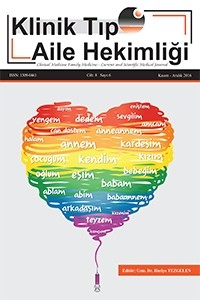Tıp Fakültesi Öğrencilerinde Tam Kan Sayımı, D vitamini, B12 Vitamini, Hepatit A ve Hepatit B Tarama Sonuçları
Tıp Öğrencisi, Bağışıklama, Farkındalık
Evaluation of The Results of Complete Blood Count,Vitamin D, Vitamin B12, Hepatitis A and Hepatitis B Screening in Medical School Students
Medical student, Immunization, Awareness,
___
- Kaynaklar 1. World Health Organisation (WHO). Position paper on Hepa-tit A vaccines. Geneva: World Health Organization. 2010[http:// www.who.international]. 2.European Association for the Study of the Liver. EASL clini-cal practice guidelines: management of chronic hepatitis B.J Hepatol. 2009;50(2):227–42. 3. Mistik R: The epidemiology of viral hepatitis in Turkey: analy-sis of published data. In Viral Hepatit. Volume 1. 1 edition.Edited by: Tabak F. Istanbul:Viral Hepatit Savasim Derne-gi; 2007:10-50. 4. Nelson KP, Mathers MB, Cowie B, Hagan H, Jarlais DD, Hory-niak D, at al. Lancet. 2011; 378: 571-83. Epub 2011 Jul 27. 5. Riaz M, Idrees M, Kanwal H, Kabir F. An overview of Triple in-fection with Hepatitis B, C and D viruses. Virol J. 2011; 8: 368. 6. Çetin M, Temiz M, Aslan A, Turhan E. Mustafa Kemal Üni-versitesi Tıp Fakültesi Hastanesi araştırma görevlilerinin he-patit B virusu infeksiyonuna ilişkin bilgi düzeylerinin değer-lendirilmesi. Viral Hepatit Dergisi. 2007; 12(3): 121-7. 7. Cesur Y. Hyperthyrodism in childhood and Adölescence. Türkiye Klinikleri J Pediatr Sci. 2006;2(10):115-32. 8. Torresi J, Johnson D, Wedemeyer H. Progress in the develop-ment of preventive and therapeutic vaccines for hepatitis C vi-rus. J Hepatol. 2011; 54: 1273-85. Epub 2011 Jan 12. 9. 10Freire WB.Strategies of the Pan American Health Organi-zation/World Health Organization for the control of iron de-ficiency in Latin America. Nutr Rev. 1997; 55:183-8. 10.http://apps.who.int/iris/bitstream/10665/177094/1/9789241564960_eng.pdf?ua=1&ua=1 available:12.12.2017. 11.WHO/UNICEF. Iron Deficiency Anaemia: Assessment, pre-vention, and control. Geneva: World Health Organization, 2001(WHO/NHD/ 01.3). (http://www. who.int/nut/documents/ida_assessment_prevention_ control.pdf, accessed 03 March 2009.) 12. Kimlin MG, Olds WJ, Moore MR. Location and vitamin Dsynthesis: is the hypothesis validated by geophysical data? JPhotochem Photobiol B 2007;86(3):234-9. 13. Lee JH, O’Keefe JH, Bell D, Hensrud DD, Holick MF. Vita-min D deficiency an important, common, and easily treatab-le cardiovascular risk factor? J Am Coll Cardiol 2008;52(24):1949-56. 14. Edey M, Barraclough K, Johnson DW. Review article: Hepa-titis B and dialysis. Nephrology (Carlton). 2010; 15: 137-45.15. Bonanni P,Pesavento G, Boccalini S, Bechini A. Perspecti-vesof public health: present and foresen impact of vaccina-tion on yhe epidemiology of hepatitis B. J Hepatol.2003;39:224-9. 16. Genişletilmiş bağışıklama programı Genelgesi. T.C. Sağlık Ba-kanlığı Temel Sağlık Hizmetleri Genel Müdürlüğü,2006:18607. 17. Shin BM,Yoo HM,Lee AS, Park SK. Seroprevelance of hepa-titis V Virus among health care workers in korea. J KoreanMed Sci. 2006;21 (1):58-62. 18. Pavlapoulou ID, Daikos GL,Tzivaras A et al. Medical and Nur-sing student with suboptimal protective immunity aganist vac-cine-preventable diseases. Infect Control Hosp Epidemol.2009;30(10):1006-11. 19. Kutlu R, Çivi S, Aslan R. Tıp Fakültesi Kız Öğrencilerinde Kı-zamık, Kızamıkçık, Kabakulak ve Hepatit B Seroprevalansı TAFPrev Med Bull 2011; 10(5): 549-556). 20. Kader Ç, Yolcu S, Erbay A, Kılıç AN, Yüzer S, Polat S. Bo-zok Üniversitesi Sağlık Yüksek Okulu Öğrencilerinde Hepa-tit-B ve C Seroprevelanslarının Araştırılması Viral Hepatit Der-gisi 2013; 19(2): 49-53. 21. Jacobsen K, Wiersma S. Hepatitis A virüs Seroprevelance by AgeAnd World Region, 1990 and 2005. Vaccine 2010:28:6653-7. 22.Al Faleh F, Al Shehri S, Al Ansari S, Al Jeffri M, Al MazrouY, Shaffi A et al. Changing patterns of Hepatitis A Prevelan-ce Within The Saudi population over The Last 18 Years. WorldJ Gastroenterol. 2008;14:7371-5. 23. Coppola RC, Minerba L, Masia G. Epidemiological perspec-tives Of Viral Hepatitis in Italy. Journal Of Preventive Medicine And Hygiene. 1999;40:8-1 24. Yüksel Koçdoğan F. İstanbul’da farklı yaş gruplarında hepa-tit A seroprevalansı ve sosyoekonomik faktörlerle ilişkisi. Uz-manlık Tezi. İstanbul: Haydarpaşa Eğitim ve Araştırma Hastanesi, İnfeksiyon Hastalıkları ve Klinik Mikrobiyoloji Ana-bilim Dalı, 2006.) 25. Çetinkol Y, Altunçekiç Yıldırım A. The Evaluation Of The HbsAg, Anti-HBs, Anti- HCV And Anti-HAV IgG Results in Me-dical Career College Student Viral Hepatit Derg.2012:18(1):23-5 26. Kayhan Tetik B, Kayhan E, Demirbağ Ö, Yakıncı C. Evalua-tion of hepatitis a, b and c serological assays and completeblood count results in medical school students. J Turgut OzalMed Cent 2018;25(1):76-9. 27. Bolluk S, Akbulut G. D Vitamini ve Diabetes Mellitus. Tur-kiye Klinikleri J Endocrin 2013;8(2):65-72 28. Sahota O, Mundey MK, San P, Godber IM, Lawson N, Hos-king DJ. The relationship between vitamin D and parathyro-id hormone: calcium homeostasis, bone turnover, and bonemineral density in postmenopausal women with establishedosteoporosis. Bone 2004;35:312-9. 29. Bozkurt S, Alkan B, Yıldız F, Gümüs S, Sezer N, Ardıcoğlu Oet al. Age,Sex, and Seasonal Variations in the Serum VitaminLevels in a Local Turkish Population. Turkish Journal of Rhe-matology 2014;29(1):14-9. 30. Türkiye Diyabet, Hipertansiyon, Obezite ve Endokrinolojik Has-talıklar Prevalans Çalışması-II (TURDEP-II Çalışması) 2010 31. Sevimli R, Yakıncı C, Encan ME, Polat H, Sakçı M, Sağır Ave ark. The prevelance of Vitamin D defiency-insufficiency inmedical faculty students. J Turgut Ozal Med Cent2018;25(1):125-9. 32. Öncel K, Özbek MN, Onur H, Söker M, Ali Ceylan A. Diyar-bakır İlindeki Çocuklarda ve Adölesanlarda B12 Vitamin veFolik Asit Düzeyleri Dicle Tıp Dergisi 2006; 3 (33):163-9.33. VanderJagt DJ, Spelman K, Ambe J. et. al. Folate and vita-min B12 status of adolescent girls in northern Nigeria. J NatMed Assoc 2000; 92: 334-40. 34. Osifo BO, Lukanmbi FA, Bolodeoku JO. Reference values forserum folate, erythrocyte folate and serum cobalamin in Ni-gerian adolescents. Trop Geogr Med 1986; 38: 259-64. 35. Cristenson RH, Dert GA, Tuszynski A. Two radioassay for se-rum Vitamin B12 and folate determination compared in a re-ference interval study. Clin Chem 1985; 31: 1358- 60.
- ISSN: 1309-0461
- Başlangıç: 2009
- Yayıncı: Selen Medya Yayıncılık Tanıtım ve Organizasyon Hizmetleri
Dövme Uygulamaları Ne Kadar Güvenli
Kronik Böbrek Hastalığı Olan Çocuklarda Beslenme Desteği
İnsülin Tedavisi ve Hipoglisemi Üzerine Yapılan Çalışmalara Güncel Bakış
Üniversitesi Öğrencilerinde Güneşten Korunma Bilinci (Toplumsal DuyarlılıkProjesi)
Türkiye’de Özçekim Yaralanma ve Ölümleri
Aile Hekimliği Polikliniği'nde Renal Hücreli Karsinom Tanısı Koyulan Bir Olgu
Olgularla Kulak Enfeksiyonları
Rekürrent Aftöz Stomatitli Olgularda Hemoglobin, Demir, Ferritin ve Vitamin B12 Düzeyleri
